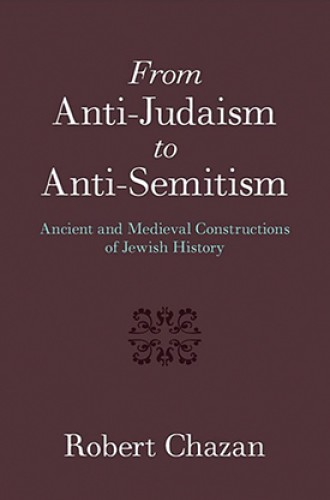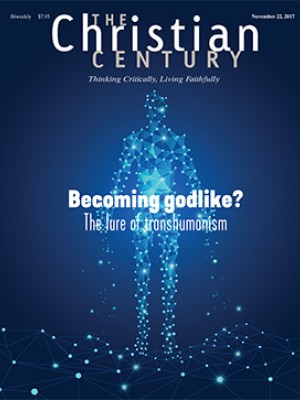Jewish history through Christian eyes
Must Christianity always define itself against Judaism? The Didache didn't.
I have long been perplexed by a question that Robert Chazan presents as a declaration: “All Christians must express fundamental negativity to their Jewish contemporaries, since these Jews continue to reject the truth of Christianity.” The words all and must challenge and trouble me; I hope they are mistaken and fear they are not.
Chazan presents considerable evidence to back up his declaration in a work that examines Christian constructions of Jewish history from the New Testament through Eusebius, Augustine, and lesser-known medieval authors, ending with Martin Luther. Given the common origins of Judaism and Christianity, Chazan observes that “a sure grasp of Christian history has meant concern with and comprehension of the history of the Jewish people.” He argues that attending to Christian constructions of Jewish history helps us trace the connections between ancient and medieval anti-Judaism and modern anti-Semitism.
Read our latest issue or browse back issues.
Overall, the ancient sources Chazan studies offer an ambivalent account of Jewish history. The synoptic Gospels present Jewish opposition to Jesus as a central motif. But they also depict positive Jewish responses to Jesus (not least in the persons of his close followers), acknowledge the Jews’ initial divine chosenness, and disagree among themselves on the degree of guilt to assign the Jewish people for the Crucifixion.
After establishing the classical era’s ambivalence toward Jews and Judaism, Chazan turns to medieval sources, giving a systematic reading of works by Bernard of Clairvaux and Peter the Venerable in the 12th century, friars Raymond Martin and Alphonso de Espina in the 13th and 15th centuries, and Luther in the 16th century. He shows church leaders contending with the ambivalence regarding Jews in their classical sources as well as the growing negative perceptions of Jews among the broader populace.
This book is also an exploration of the possibilities and limitations of intellectual leaders for influencing their societies. Chazan presents repeated evidence of disparity between the nuance and complexity in constructions of Jewish history by intellectual elites and “the normal popular desire for clear and simplistic messages.” St. Bernard sees Jews as contemptibly but docilely accepting their divine penal subjugation and dispersion, yet he acknowledges their contribution to humanity and insists on their future salvation.
As the story continues, there is evidence of “slow acceptance by European intellectual leaders of the negative perspectives germinating among the masses.” Alphonso de Espina embraces popular perceptions of Jews as physically and spiritually dangerous to Christians—as they were in antiquity, he thinks, and would be until “the very last possible moment” of time. Alphonso marches his readers to the conclusion that expulsion of the Jews from Spain is the only solution for present Christian security.
Luther makes a fitting end to this study, as his writings on Jews encapsulate the story Chazan tells of intellectual complexity embracing—or perhaps becoming unmasked by—popular simplicity. In 1523 Luther urged compassion toward Jews, who were the people of the patriarchs and prophets and of Jesus himself, and who only needed patient reasoning to correct their exegetical error and enter the Christian fold. But in 1543 Luther abandoned theological argumentation in his account of Jewish history, instead reproducing popular views. He wrote that Jews had been “blood-thirsty bloodhounds and murderers of all Christendom for more than 1,400 years in their intentions and would undoubtedly prefer to be such with their deeds.” He proposed harsh measures, from torching Jews’ synagogues and razing their homes to sequestering their capital and forcing them into manual labor until they would ultimately be expelled from Christendom.
In the wake of the Holocaust, Christians began to look more critically at anti-Jewish expressions in their traditions to discern whether they might bear some responsibility for “sowing the seeds” of modern anti-Semitism and silently allowing them to bear Nazi fruit. Chazan places direct blame for the Holocaust onto Christian texts. But he carefully avoids the assertion of direct causal continuity between Christian sacred texts and authorities and modern anti-Semitism. Chazan argues instead that “these medieval thinkers . . . served as a destructive conduit between the anti-Judaism of antiquity and the anti-Semitism of modernity.” That is, such works gave authoritative weight to negative perceptions of Jews in writings that remained available for subsequent generations to take up and adapt to their own contexts.
Even the most reasoned and compassionate constructions of Jewish history surveyed in this study can at best be described as ambivalent toward Jews. So the questions returns: Is is true that all Christians must “express fundamental negativity to their Jewish contemporaries,” softened only by positive expressions of respect for the Jewish past and hope for Jews’ ultimate salvation? The anonymous Didache from about the first century CE provides at least one example of an ancient Christian text that does not define Christianity against Judaism. But it did not make the canon.
Recent efforts at reconciliation between Jews and Christians suggest a growing Christian commitment to moving beyond ambivalence to full respect for Judaism as a living tradition with an ongoing covenant with God. If Chazan’s book teaches us anything, though, it is that strides made by church leaders in this area do not necessarily mean that the people at large have absorbed the message. Neither do such interfaith efforts erase the anti-Jewish potentials that remain within Christian sacred texts, traditions, and popular imagination. To stave off the destructive use of such texts and traditions, Christians at all levels need to commit to ongoing effort and vigilance.
A version of this article appears in the November 22 print edition under the title “Jews through Christian eyes.”






